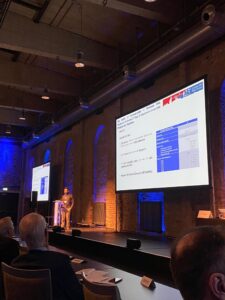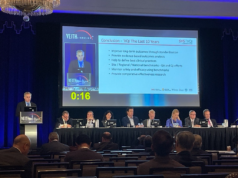
Despite being considered “generally safe”, cyanoacrylate can cause local reactions in up to 25% of patients, disproportionately affecting women, Asian race and thin patients with a body mass index of <22. This was the conclusion drawn by Eduardo Silva (Coimbra Hospital and University Centre, Coimbra, Portugal) in his presentation at this year’s European Venous Forum (EVF 2023; 22–24 June, Berlin, Germany).
Cyanoacrylate, the speaker first noted, has gained popularity in recent years for the treatment of varicose veins, due to its “minimally invasive” procedural nature and its ability to be performed in an outpatient setting. However, concern has grown in parallel to cyanoacrylate’s uptake, since increasing reports of “phlebitis-like reactions” have led some to question its safety.
These kinds of reactions have been later associated with type IV hypersensitivity, Silva explained, observing that symptoms can range from local itching, erythema, pain and swelling—typically resolving within a few days—although “severe” reactions have been reported.
Elaborating further on the typical presentation of this kind of hypersensitivity, Silva emphasised that type IV hypersensitivity often has a delayed onset, developing days to months after exposure to cyanoacrylate. Warning against expecting an immediate reaction, he made clear that “most of these will be between two to three days after the treatment”. Silva explained that these reactions occur in response to antigens produced by the subject to foreign substances that he has previously been exposed to, which, upon new exposure, triggers an “inflammatory cascade mediated by T cells”.
Using this information as the foundation of their study, Silva et al conducted a literature review using Embase and PubMed databases, evaluating the incidence and symptoms of suspected hypersensitivity reactions and their relation with phlebitis-like adverse events following cyanoacrylate varicose vein treatment.
Identifying 17 studies which reported severe complications, they highlighted 1,208 patients that had undergone cyanoacrylate varicose vein treatment, amounting to 1,631 treated veins. In total, 13 veins had to be excised in nine patients. Among these patients, the majority were female (65.8%), with a mean age of 52 years.
Looking closely at less severe reactions to cyanoacrylate treatment, Silva and his team noted 250 patients who had developed some form of adverse reaction after administration, the most common reaction being thrombophlebitis or phlebitis-like reactions (4–25.4%), however he asserted that “most complications were mild and self-limited”.
Building a portfolio of risk factors, the speaker noted that the presence of suprafascial saphenous vein location (<1cm underneath the skin), as well as larger veins (>8mm), were associated with adverse reactions to cyanoacrylate. Although Silva concluded that population characteristics and procedural factors “did not seem to influence the risk of developing hypersensitivity”.
After critically reviewing the literature, Silva concluded his presentation by asking the question: “Who should we test?” He asked if it should it be everyone? Patients with a known acrylate allergy? Or patients at risk of previous exposure? First, he considered patch testing all patients pre-procedure, stating that this “can be very useful to identify patients that might be at risk of developing hypersensitivity,” though he warned that “exposing everyone to [patch testing] may actually be causing first exposure and sensitising the patient”.
Secondly, revealing a trick question, Silva eliminated patients with a known acrylate allergy completely, stating that these patients “should not be treated [with cyanoacrylate] at all”. Looking at his third option, he concluded that patients at risk of previous exposure should be considered for testing, although “many patients do not know they have been previously exposed,” posing difficulties for healthcare providers.
Providing a clear overview of their findings, Silva conveyed that cyanoacrylate is “a safe treatment”, but discussion needs to address the differences between phlebitis-like reactions and “classic” thrombophlebitis. Finally, he emphasised the importance of “developing protocols to identify and reduce hypersensitivity reactions,” and urged physicians to consider referral to clinical allergists “when in doubt”.












